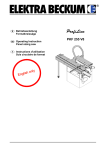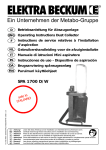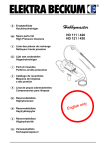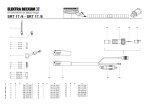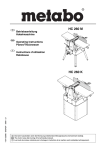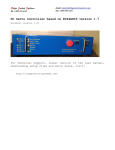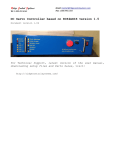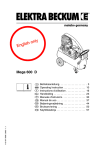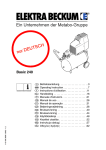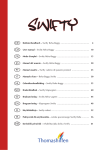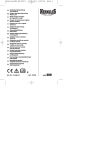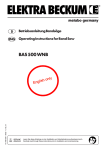Download Metabo Welding Machine MIG/MAG 160 Specifications
Transcript
G Operating Instruction Welding machine F Instructions d'utilisation L’appareil de soudage sous gaz protecteur N Bruksanvisning Dekkgass-sveiseapparatet J Käyttökäsikirja Parhaat onnittelumme tämän korkealaatuisen S Bruksanvisning skyddsgassvets MIG/MAG 140 MIG/MAG 160 Great Britain Please return the enclosed warranty card to us. Retain proof of purchase! You are only entitled to claim warranty against proof of purchase. Please see back cover for manufacturer representative´s address nearest you. 1. France SVP, retournez-nous la carte de garantie jointe. Conservez le reçu d'achat! La garantie ne peut être accordée que sur présentation de ce reçu. Vous trouverez l'adresse de votre représentant le plus proche à la dernière page de couverture. 2. N Norge Send vedlagte garantikort tilbake til oss. Oppbevar kvitteringen! Garantiytelser skjer kun på grunnlag av forelagt kvittering. Adressen til ditt nærmeste serviceverksted finner du bak på siste omslagside. 3. J Suomi/ Finland Ole hyvä ja palauta oheinen takuukortti meille. Säilytä ostokuitti! Takuu on voimassa vain kuittia vastaan. Lähimmän edustajan osoite löytyy takakannesta. 4. S Sverige Återsänd medföljande garantisedel till oss. Förvara kvittot! Garantianspråk erkännes endast mot uppvisande av kvitto. Adressen till närmaste representant finns på bakre uppslagets insid. 5. G F Redaktion: Zindel • Technische Dokumentation und Multimedia • D-22417 Hamburg XS0006E.fm 1Great Britain Operation elements cause disturbances to other consumers in the distribution system. Check with your power utility before connecting to power. Keep the welding machine out of the reach of children. 1 Please note the hazards associated with the welding process and observe any work and fire prevention regulations. The welding machine is not suitable for outdoor use in rain. Store in a dry place. 2 3 4 5 1 Connection for torch 2 Switch on/off and welding currant 3 Wire feed regulator 4 Overload control light 5 Connection for earth clamp Dear customer, Congratulations to your purchase of this high-quality MIG/MAG welding machine. To ensure your personal safety and for reasons of appliance safety we ask you to read the instructions completely before operating this machine and to observe all points. A Danger! person with a heart condition wearing a pace maker must contact their doctor before operating this welding machine. Safety Information and Accident Prevention Measures · Keep the welding machine out of the reach of children. · Observe all applicable work and fire prevention regulations when operating this welding machine. Observe all applicable accident prevention regulations. · With welding a number of different hazards are associated, which can pose a danger to health under certain circumstances. · When welding always wear a close fitting, dry overall (preferably fire retardant welders apparel) unsoiled by combustible substances, sturdy, insulating boots, headgear and leather welders gloves. · Clothing made of synthetic fabrics and shoes are not suitable. Dry, insulating gloves worn on both hands protect against electric shock (open-circuit voltage of the welding current circuit), hazardous rays (heat and ultra-violet rays) as well as against glowing metals and slag spatters. The ultra-violet radiation causes sunburn-like effects on unprotected parts of the body. Basic Information for the Operator The MIG/MAG welding machine is a DC welding power source with integrated wire feed, designed and manufactured exclusively for MIG and MAG electric arc welding. Any other use of this machine involves dangers and is not permitted. The welding machine must only be operated on the mains voltage stated on the machine's rating plate. Connection to the supply circuit must be made via an earthed outlet, installed by a qualified electrician. The supply circuit must be protected by a fuse or miniature circuit breaker. Depending on the mains connection conditions at the point of connection, welding power sources can MIG/MAG 140/160 1.1 Fumes – Vapours – Smoke Fire · During welding hazardous smoke and metal dust develops. We strongly recommend the wearing of welding fume respirators, and to weld only in sufficiently vented rooms, to ensure the necessary operator protection. · For enclosed spaces forced ventilation, installed below the welding area, must be used. · The material to be welded must be free from halogen solvents or degreasing agents, to prevent the generation of toxic vapours. · Metals coated with lead, graphite, cadmium, zinc, mercury or beryllium, or containing any of these materials, can generate much smoke during welding. A Danger! The arc temperature is approx. 2400 ˚C. · Welding releases ozone, which is a type of oxygen that can lead to irritation or disorder of the respiratory organs. · Degreasing agents such as trichlorethylene, tetrachloroethylene etc. vaporise during welding and are chemically converted into phosgene. Phosgene is poisonous! UV-Rays · The arc radiation can cause eye damage and skin burns. · For protection against sparks, heat, visible and invisible rays suitable eye protection gear (welding visor or helmet with standardised filter lenses to class 10 – 15 of DIN 4647, depending on welding current) must be worn. · Do not look into the arc with unprotected eyes (risk of blinding and burns). The invisible ultraviolet radiation causes, with insufficient eye protection, a very painful conjunctivitis, which appears only hours later. · Weld only within the range of visibility of other persons, who can assist you in an emergency. · Other persons or helpers near the arc must be made aware of the hazards, and equipped with the necessary protective gear. · Neighbouring workplaces are to be screened off to provide protection against radiation. · When welding inside rooms and buildings sufficient ventilation must be ensured. 1.2 Before starting to weld observe the following information: · Remove all combustible materials and objects within a radius of 5 m from the welding point. · Materials that can not be removed within a 5 m radius must be protected by covering with sheet metal, wet cloths etc. · Any wall openings, cracks and the like must be covered or sealed respectively, to prevent uncontrolled flying of sparks. · Keep fire extinguishing equipment such as fire extinguisher, water pale etc. at hand. · Keep in mind that by heat dissipation from the welding point a fire may be started on covered parts or in other rooms respectively. · After completion of the welding work check the vicinity of the welding point several times within a period of 6 – 8 hours for heat conduction, glowing combustion spots, hidden seats of fire etc. Handling of Shielding Gas Cylinders · Observe all applicable regulations pertaining to the handling of gas cylinders. Because of the dangerously high internal pressure (up to 200 bar) shielding gas cylinders are to be specially protected against mechanical damage, falling over or falling down, heating up (max. 50˚C), prolonged radiation by sunlight and heavy frost. · When the welding machine is equipped with a gas cylinder too large in size this can cause, on uneven ground, the welding machine to fall over. To prevent subsequent damage to the welding machine or the gas cylinder, use only proper size gas cylinders (10l / 20l cylinders). · Have cylinders refilled only by authorised filling stations. MIG/MAG 140/160 Electrical Hazards · The connection to power mains and servicing of the welding machine is to be done in accordance with VDE regulations or other standards applicable in your area. · Ensure proper protective bonding of the supply circuit. · Ensure proper protective bonding of the workbench. · Any service or maintenance work must only be carried out by qualified personnel. · Replace defective or damaged parts of torch or torch leads without delay. · The unit must only be connected to an earthed outlet as a matter of principle. Only connections, including outlets and extension cables with an earthed plug, having an earth conductor and installed by a qualified electrician, are permitted. · The fuse protection of the supply circuit must be in accordance with local regulations. According to these regulations fuses or miniature circuit breakers respectively, suitable for the conductor cross section, must be installed. Installation of a fuse with to high an ampere rating may cause line fire and subsequent fire damage to the building. · Replace damaged torch insulation and welding cables without delay. · Replacement of a damaged power cable, plug etc. and repairs to the electrical components of the welding machine must be left to a qualified electrician. · Welding torches must not be held in an armlock, or in such way that electricity can run through the body. · Switch the unit off for longer work breaks. Unplug when work is completed and before relocating the unit. In case of accidents separate the welding power source at once from the power supply. General Machine Description The MIG/MAG welding machine consists of a transformer, a series-connected silicon rectifier, a welding circuit choke, and a wire feed unit. The welding machine is suitable for the welding of different electrode wires (e.g. steel, see "Technical Specifications") under a shielding gas cover (CO2, mixed gas and argon). The machine is fan cooled and has an overload protection. MIG/MAG 140/160 Commissioning Taking out of enclosed parts All enclosed parts are inside the wire feed compartment and can be taken out after the wire feed compartment cover is removed.. Installation Conditions The MIG/MAG welding machine is to be set up in dry surroundings with enough space to ensure sufficient cooling. The welding machine is designed for indoor use. It must not be use outdoors in rain. Mains connection · Check to see that mains voltage matches the voltage shown on the machine's rating plate. · Set welding step switch to "0" before plugging in. Shielding gas cylinder connection · Place gas cylinder onto the welding machine's cylinder rack and secure with the chain to the cylinder holder at the rear of the unit. Take off the cylinder cap and open cylinder valve briefly, facing away from your body. · Screw pressure reducer to the gas cylinder valve. Run gas hose from pressure reducer to gas inlet port of the unit. · Recommended gas flow rate in draft-free rooms: 5-10 l/min. · When using adjustable pressure reducers set flow rate according to litre scale in the clock with the T-screw. Turning the T-screw in increases the gas flow rate, turning it out reduces the gas flow rate. · While setting the gas flow rate, the unit must be switched on and the torch's trigger switch held down, so the solenoid gas valve is open. To prevent wasting electrode wire swing the wire feed unit's leaf spring to the side. Modifications and repairs to pressure reducers are strictly prohibited due to the hazards involved. Send faulty pressure reducers to a service centre. 1.3 Earth lead connection Connect earth clamp of the unit's earth cable as close as possible to the welding point. Ensure good metal to metal contact. Preparation of the welds The joint section of the workpieces to be welded must be free of colour, metall covering, dirt, rust, grease and humidity. The preparation of the welds is to be done under observation of all welding techniques regulations. Hints for Setting and Welding Techniques Switching the unit on The unit is switched on with the combination ON/ OFF – welding step switch. With the switch in the "0"- position the unit is electrically separated from the power supply. The unit is fitted with an embedded temperature detector, which shuts the unit down in case of an thermal overload. Form of joint s I-joint onesided I-joint on both sides b V-joint s 25 b K-joint s Double-K-joint Setting the welding parameters After preparation of the welding machine the welding can begin. To do so, welding voltage and wire feed have to be matched to suit the welding task. If the wire feed speed is increased the welding current increases accordingly. For every electrode wire diameter and every welding task optimal parameters can be found. They are recognisable at the typical humming sound of the arc, amongst other. If there is too much deviation from the optimal parameters, a satisfactory welding is not possible. The right joint The list gives hints for the shaping of the joints. Execution Platethickness s (mm) Gapwidth b (mm) < 1,5 > 1,5 0 <2 2–4 <2 3–6 <1 3–6 <1 > 0,6 – 0,6 – 1,5 – > 0,6 – >1 – s Cornerjoint The tripping of the thermal overload protector is indicated by the front panel control light. Welding power source and wire feed are temporarily disabled. After cooling down the welding power source is automatically activated again, the control light extinguishes. 1.4 MIG/MAG 140/160 Care and Maintenance The unit is nearly maintenance-free. – Voltage! B Danger Disconnect from power before servicing! · Check feed roller, pressure roller and wire leadin nozzle at regular intervals for dirt build-up, clean if necessary. · At appropriate intervals the complete torch including torch leads should be cleaned, as rubbed-off parts and dust build-up inside. · The torch's contact tip is a wearing part. If its orifice has enlarged the contact tip must be replaced. · On the inside of the plug-on gas shroud spatters build up. These have to be removed when necessary. An anti-spatter spray eases this job and keeps spatters from sticking to the shroud. · Replace damaged cables without delay. Trouble Shooting Mechanical faults are mostly indicated by an irregular or completely blocked wire feed. Electrical faults cause a malfunction of the unit, in part or complete. - Voltage! B Danger Electrical fault finding must be left to a qualified electrician. Further fault finding can proceed according to the wiring diagram supplied. Fault find should first start with the unit de-energized, and in the following order: 1. Check of the power supply cable connection and all other connections on switches, transformer and choke, as well as all plug-and-socket connections and soldered connections for tightness. 2. Check of fuse for continuity and contact. 3. Visual check for possible shorts or overloads of windings (discoloring). Fault, Likely causes Remedy • Noisy or unstable arc? Incorrect welding voltage Correct with welding step switch Too much/too little wire feed Correct with wire feed pot Earth clamp loose or high contact resistance (rust, paint) Ensure good contact between earth clamp and workpiece Contact tip worn or incorrect diameter Replace Incorrect gas flow rate setting Correct Workpiece not clean in seam area Remove paint, rust, grease etc. Power unit faulty Have machine checked by service centre Spiral liner dirty Clean or replace Wire feed faulty See below • Excessive spattering Wire feed rate too high Correct with wire feed pot Welding voltage too high Correct with welding step switch Workpiece not clean Clean • Wire feed motor does not run No power Check power supply Welding step switch in "0" position Set to a welding step Torch trigger switch not activated Activate torch trigger switch Fuse blown Have replaced by a qualified electrician Motor faulty Have repaired by service centre • No wire feed Pressure roller loose Increase pressure of leaf spring with knurled thumb screw Wire kinked at wire feed Adjust wire lead-in nozzle Groove in feed roller worn Replace Electrode wire stuck to contact tip Replace contact tip, if wire is deformed, reduce pressure of pressure roller • Machine shuts down, overload control light comes on MIG/MAG 140/160 Duty cycle exceeded Let machine cool down, observe duty cycle stated on nameplate Power unit faulty Have repaired by service centre. 1.5 Technical Specification MIG/MAG 140 MIG/MAG 160 Power supply 1 x 230 V, 50/60 Hz 1 x 230 V, 50/60 Hz Power input max. 4,4 kVA 4,4 kVA Current draw max. 21 A 20 A Mains fuse, time-lag 16 A 16 A Open-circuit voltage 17,5 – 28 V 19 – 30 V Welding current range 30 – 140 A 30 – 160 A max. Duty cycle at 145 A 7% 15 % Welding steps 4 4 Wire feed rate 1,0 – 12 m/min 1,0 – 12 m/min Electrode wire diameter 0,6 – 0,8 mm 0,6 – 0,8 mm Insulation class N N Protection class IP 21 IP 21 Length x Width x Height 590 x 260 x 420 mm 590 x 260 x 420 mm Weight 26 kg 28 kg Circuit diagram S1 L1 max Ø min 1B S2 1 1 1 2 1A 4 1B 3 L1 T1 L1 A 2 2A 1 C 2 1 T1 U1 L1 A M1 N N 2 2 B 2 S1 6 1A 2B 1 1 3 3 4 3 6 4 B U1 S2 S3 M1 10 11 H1 H1 12 TH TH 3 3 M2 2 5 4 M2 L1 2 5 4 L1 P1 P1 TV TV VA R - 0 3 VA R - 0 3 1 N1 N1 1 N N MIG/MAG 140 1.6 MIG/MAG 160 MIG/MAG 140/160 B Belgium Elektra Beckum Belgium N.V.S.A. Industriezone Hofte te Bollebeeklaan B-1730 Asse-Mollem Tel.: 0032-24540454 Fax: 0032-24540450 D Deutschland G I Elektra Beckum AG Daimlerstraße 1 D-49716 Meppen Tel.: 01803-333 456 Fax: 01803-333 457 K Danmark Elektra Beckum Danmark Lundeborgvej 9 Postbox 8113 DK-9220 Aalborg OE Tel.: 0045-98-151300 Fax: 0045-98-151451 E España France N H Suomi/ Finland Nofa OY P.O.Box 28 Hannuksentie 1 FIN-02270 Espoo Tel.: 00358-9804-861 Fax: 00358-9803-9485 MIG/MAG 140/160 Italia Norge Profilma-Import A/S Postboks 536 Nanset Sophus Buggesvei 48 N-3252 Larvik Tel.: 0047-33114777 Fax: 0047-33114108 Nederland Elektra Beckum Nederland Einsteinstraat 15 NL-1704 RT Heerhugowaard Tel.: 0031-7257-44660 Fax: 0031-7257-44250 P J. Muller 1.Place de Lábattoir F-67190 Mutzig Tel.: 00333-88479971 Fax: 00333-88479970 J Elektra Beckum Machinery Ltd. 6 The Quadrangle Premier Way GB-SO51 9AQ Romsey Tel.: 0044-1794-834900 Fax: 0044-1794830083 Elektra Beckum AG Germania Daimlerstraße 1 D-49716 Meppen Tel.: 0049-1803-333456 Fax: 0049-1803-333457 Elektra Beckum Import S.A. Calle Alejandro Coicoechea 6 E-08960 Sant Just Desvern Tel.: 0034-9-34739009 Fax: 0034-9-34739755 F Great Britain Portugal Costa & Garcia S. A. Vilar do Paraíso, Ap. 23 P-4408 Valadares Tel.: 00351-2-7121279 Fax: 00351-2-7124670 S Sverige HDF-Paulsson AB Box 525 Svaravaregatan 5 S-30180 Halmstad Tel.: 0046-35-154400 Fax: 0046-35-121780 115 164 4534 GB/F/N/SF/S 3298 1.0









